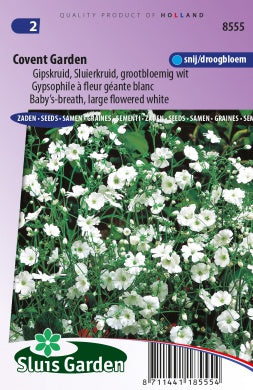1
/
of
1
Baby’s breath large flowered White
Baby’s breath large flowered White
Regular price
1.350 KWD
Regular price
Sale price
1.350 KWD
Unit price
/
per
Shipping calculated at checkout.
Couldn't load pickup availability
Growing *Baby's Breath (Gypsophila paniculata)*, especially the large-flowered white variety, can add delicate and airy blooms to your garden. Here's a guide on how to grow Baby's Breath:
**1. Planting Time:**
- Baby's Breath can be grown from seeds or transplants. If growing from seeds, start them indoors about 6-8 weeks before the last expected frost. Transplant seedlings outdoors after the danger of frost has passed.
**2. Location:**
- Choose a location with full sun. Baby's Breath prefers well-lit areas.
**3. Soil Preparation:**
- Baby's Breath thrives in well-draining soil. It's not too particular about soil type but prefers slightly alkaline conditions. Incorporate organic matter, like compost, to improve soil fertility.
**4. Planting Seeds or Transplants:**
- If starting seeds indoors, sow them in trays or pots. Press the seeds gently into the soil surface, and cover lightly. Keep the soil consistently moist until germination. Once seedlings are large enough, transplant them to the garden with proper spacing.
**5. Spacing:**
- Space Baby's Breath plants about 12 to 18 inches apart to provide adequate room for growth.
**6. Watering:**
- Baby's Breath prefers slightly dry conditions. Water the plants when the soil is dry to the touch. Ensure good drainage to prevent waterlogging.
**7. Mulching:**
- Apply a layer of mulch around the plants to help retain soil moisture and suppress weeds. Mulching also helps regulate soil temperature.
**8. Fertilization:**
- Baby's Breath is not a heavy feeder. A well-balanced fertilizer applied in the spring is usually sufficient for its needs.
**9. Support:**
- While Baby's Breath is generally sturdy, providing some support with stakes may be beneficial, especially in windy conditions.
**10. Pruning:**
- Deadhead spent flowers regularly to encourage continuous blooming. Pruning can also help maintain a neat appearance.
**11. Disease and Pest Resistance:**
- Baby's Breath is relatively resistant to pests and diseases. However, good garden hygiene and proper spacing can help prevent potential issues.
**12. Winter Care:**
- Baby's Breath is generally hardy, and established plants can withstand winter conditions. In colder climates, a layer of mulch can provide additional protection.
**13. Cut Flowers:**
- Baby's Breath is widely used as a cut flower in floral arrangements. Harvest stems when about 1/3 to 1/2 of the flowers are open.
**14. Companion Planting:**
- Baby's Breath can be a great companion plant, providing a delicate backdrop to more substantial flowers in the garden.
**15. Re-Seeding:**
- Baby's Breath can be prolific in self-seeding. If you want to control its spread, deadhead flowers before they go to seed.
By following these general guidelines, you can cultivate a beautiful display of large-flowered white Baby's Breath in your garden. Adjust your care routine based on your specific growing conditions.
**1. Planting Time:**
- Baby's Breath can be grown from seeds or transplants. If growing from seeds, start them indoors about 6-8 weeks before the last expected frost. Transplant seedlings outdoors after the danger of frost has passed.
**2. Location:**
- Choose a location with full sun. Baby's Breath prefers well-lit areas.
**3. Soil Preparation:**
- Baby's Breath thrives in well-draining soil. It's not too particular about soil type but prefers slightly alkaline conditions. Incorporate organic matter, like compost, to improve soil fertility.
**4. Planting Seeds or Transplants:**
- If starting seeds indoors, sow them in trays or pots. Press the seeds gently into the soil surface, and cover lightly. Keep the soil consistently moist until germination. Once seedlings are large enough, transplant them to the garden with proper spacing.
**5. Spacing:**
- Space Baby's Breath plants about 12 to 18 inches apart to provide adequate room for growth.
**6. Watering:**
- Baby's Breath prefers slightly dry conditions. Water the plants when the soil is dry to the touch. Ensure good drainage to prevent waterlogging.
**7. Mulching:**
- Apply a layer of mulch around the plants to help retain soil moisture and suppress weeds. Mulching also helps regulate soil temperature.
**8. Fertilization:**
- Baby's Breath is not a heavy feeder. A well-balanced fertilizer applied in the spring is usually sufficient for its needs.
**9. Support:**
- While Baby's Breath is generally sturdy, providing some support with stakes may be beneficial, especially in windy conditions.
**10. Pruning:**
- Deadhead spent flowers regularly to encourage continuous blooming. Pruning can also help maintain a neat appearance.
**11. Disease and Pest Resistance:**
- Baby's Breath is relatively resistant to pests and diseases. However, good garden hygiene and proper spacing can help prevent potential issues.
**12. Winter Care:**
- Baby's Breath is generally hardy, and established plants can withstand winter conditions. In colder climates, a layer of mulch can provide additional protection.
**13. Cut Flowers:**
- Baby's Breath is widely used as a cut flower in floral arrangements. Harvest stems when about 1/3 to 1/2 of the flowers are open.
**14. Companion Planting:**
- Baby's Breath can be a great companion plant, providing a delicate backdrop to more substantial flowers in the garden.
**15. Re-Seeding:**
- Baby's Breath can be prolific in self-seeding. If you want to control its spread, deadhead flowers before they go to seed.
By following these general guidelines, you can cultivate a beautiful display of large-flowered white Baby's Breath in your garden. Adjust your care routine based on your specific growing conditions.
Share

